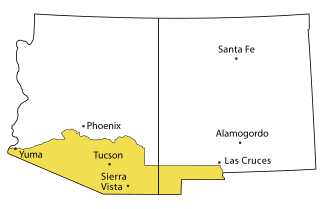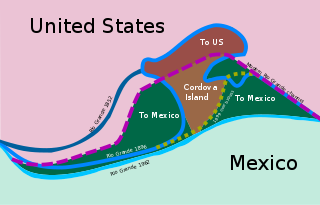
The economy of Mexico is a developing market economy. It is the 15th largest in the world in nominal terms and the 11th largest by purchasing power parity, according to the International Monetary Fund. Since the 1994 crisis, administrations have improved the country's macroeconomic fundamentals. Mexico was not significantly influenced by the 2002 South American crisis, and maintained positive, although low, rates of growth after a brief period of stagnation in 2001. However, Mexico was one of the Latin American nations most affected by the 2008 recession with its Gross Domestic Product contracting by more than 6% in that year.

Though the Ministry of Foreign Affairs (MOFA) is the government agency responsible for the conduct of foreign relations of Nepal, historically, it is the Office of Prime Minister (PMO) that has exercised the authority to formulate and conduct policies related to Nepal's foreign affairs. As a landlocked country wedged between two larger and far stronger powers, Nepal has tried to maintain good relations with both of its neighbors, People's Republic of China and Republic of India. However, its relationship with India, the country with greater hegemonic power over Nepal, has seen major ups and downs in recent years. The relationship between the two countries was significantly hampered during the 2015 Nepal blockade. Where the Nepal Government accused India of the blockade, India strictly denied the allegation and said the blockade were imposed by Madheshi protesters. For the most part though, Nepal has traditionally maintained a non-aligned policy and enjoys friendly relations with its neighboring countries and almost all the major countries of the world.

The North American Free Trade Agreement was an agreement signed by Canada, Mexico, and the United States that created a trilateral trade bloc in North America. The agreement came into force on January 1, 1994, and superseded the 1988 Canada–United States Free Trade Agreement between the United States and Canada. The NAFTA trade bloc formed one of the largest trade blocs in the world by gross domestic product.

The United Nations Environment Programme (UNEP) is responsible for coordinating responses to environmental issues within the United Nations system. It was established by Maurice Strong, its first director, after the United Nations Conference on the Human Environment in Stockholm in June 1972. Its mandate is to provide leadership, deliver science and develop solutions on a wide range of issues, including climate change, the management of marine and terrestrial ecosystems, and green economic development. The organization also develops international environmental agreements; publishes and promotes environmental science and helps national governments achieve environmental targets.

The Gadsden Purchase is a 29,670-square-mile (76,800 km2) region of present-day southern Arizona and southwestern New Mexico that the United States acquired from Mexico by the Treaty of Mesilla, which took effect on June 8, 1854. The purchase included lands south of the Gila River and west of the Rio Grande where the U.S. wanted to build a transcontinental railroad along a deep southern route, which the Southern Pacific Railroad later completed in 1881–1883. The purchase also aimed to resolve other border issues.

The Adams–Onís Treaty of 1819, also known as the Transcontinental Treaty, the Florida Purchase Treaty, or the Florida Treaty, was a treaty between the United States and Spain in 1819 that ceded Florida to the U.S. and defined the boundary between the U.S. and New Spain. It settled a standing border dispute between the two countries and was considered a triumph of American diplomacy. It came in the midst of increasing tensions related to Spain's territorial boundaries in North America against the United States and the United Kingdom in the aftermath of the American Revolution; it also came during the Latin American wars of independence.

The Inter-American Development Bank is the largest source of development financing for Latin America and the Caribbean. Established in 1959, the IDB supports Latin American and Caribbean economic development, social development and regional integration by lending to governments and government agencies, including State corporations.

The Territory of New Mexico was an organized incorporated territory of the United States that existed from September 9, 1850, until January 6, 1912, when the remaining extent of the territory was admitted to the Union as the State of New Mexico, making it the longest-lived organized incorporated territory of the United States, lasting approximately 62 years.

The Chamizal dispute was a border conflict over about 600 acres (2.4 km2) on the Mexico–United States border between El Paso, Texas, and Ciudad Juárez, Chihuahua. It was caused by a shift in the Rio Grande, as a survey presented in 1852 marked differences between the bed of the Rio Grande and the present channel of the river. Tensions over the territory during the historic Taft–Diaz summit almost resulted in the attempted assassination of both presidents on October 16, 1909.

The Economic Cooperation Organization or ECO is an Asian political and economic intergovernmental organization which was founded in 1985 in Tehran by the leaders of Iran, Pakistan, and Turkey. It provides a platform to discuss ways to improve development and promote trade and investment opportunities. The ECO is an ad hoc organisation under the United Nations Charter. The objective is to establish a single market for goods and services, much like the European Union. The ECO's secretariat and cultural department are located in Iran, its economic bureau is in Turkey and its scientific bureau is situated in Pakistan.
The Stability Pact for Southeastern Europe was an institution aimed at strengthening peace, democracy, human rights and economy in the countries of South Eastern Europe from 1999 to 2008. It was replaced by the Regional Cooperation Council (RCC) in February 2008. The RCC replaced it because it is more "regionally owned" than the Stability Pact, which was driven more by outside partners such as the EU.
The Commission for Environmental Cooperation was established by Canada, Mexico, and the United States to implement the North American Agreement on Environmental Cooperation (NAAEC), the environmental side accord to the North American Free Trade Agreement. The CEC's mission is to facilitate cooperation and public participation to foster conservation, protection and enhancement of the North American environment for the benefit of present and future generations, in the context of increasing economic, trade and social links among Canada, Mexico and the United States.
In the United States, a colonia is a type of unincorporated, low-income, slum area located along the Mexico–United States border region that emerged with the advent of shanty towns. These colonias consist of peri-urban subdivisions of substandard housing lacking in basic services such as potable water, electricity, paved roads, proper drainage, and waste management. Often situated in geographically inferior locations, such as former agricultural floodplains, colonias suffer from associated issues like flooding. Furthermore, urbanization practices have amplified the issues, such as when developers strip topsoil from the ground in order to subdivide land, the resulting plains become breeding grounds for mosquitoes and disease. Traditional homeownership financing methods are rare amongst colonias residents, and therefore these areas consist of ramshackle housing units built incrementally with found material on expanses of undeveloped land. Colonias have a predominant Latino population where 85 percent of those Latinos under the age of 18 are United States citizens. The U.S. has viewed border communities as a place of lawlessness, poverty, backwardness, and ethnic difference.

The Nordic Investment Bank (NIB) is an international financial institution founded in 1975 by the five Nordic states. In 2005, the three Baltic countries also became members of the Bank. NIB’s headquarters are located in Helsinki, Finland. NIB acquires the funds for its lending by borrowing on the international capital markets.
Anti-environmentalism is a movement that favors loose environmental regulation in favor of economic benefits and opposes strict environmental regulation aimed at preserving nature and the planet. Anti-environmentalists seek to persuade the public that environmental policy impacts society negatively. The movement's goals include to counter the effects of environmental ideology and movements, to redirect and diminish public concern about the environment, to discredit left-leaning environmentalists, and to persuade politicians against increased environmental regulation.

The North American Development Bank (NADB) is a binational financial institution capitalized and governed equally by the Federal Governments of the United States of America and Mexico for the purpose of financing environmental projects certified by the Border Environment Cooperation Commission (BECC).

The Central American Integration System has been the economic and political organization of Central American states since February 1, 1993. On December 13, 1991, the ODECA countries signed the Protocol of Tegucigalpa, extending earlier cooperation for regional peace, political freedom, democracy and economic development. SICA's General Secretariat is in El Salvador.
North American integration is the process of economic and political integration in North America, particularly integration of Canada, Mexico, and the United States.

The Global Green Growth Institute (GGGI) is a treaty-based international organization headquartered in Seoul, South Korea. The organization aims to promote green growth, a growth paradigm that is characterized by a balance of economic growth and environmental sustainability. GGGI provides research and stakeholder engagement for green growth plans, especially in developing countries, aiming to replace the more typical paradigm based on industrial development.













